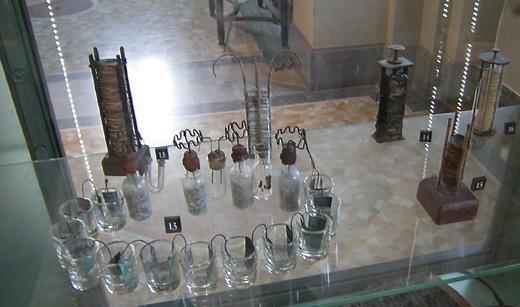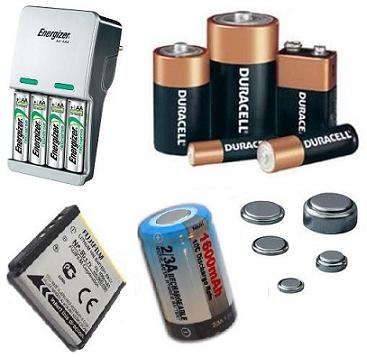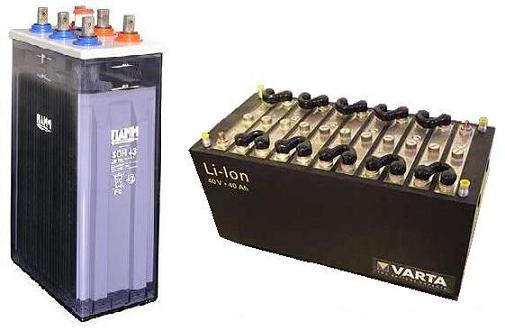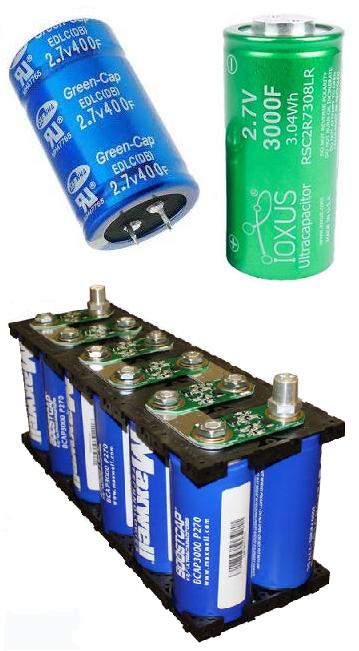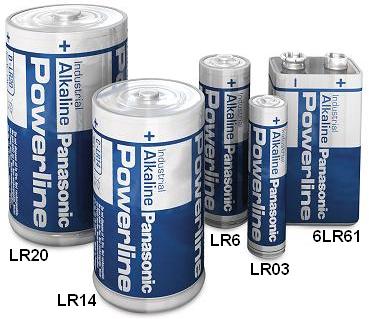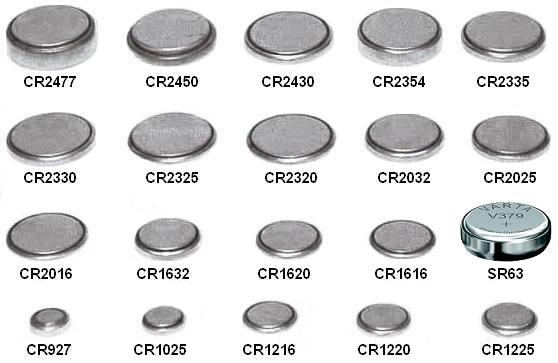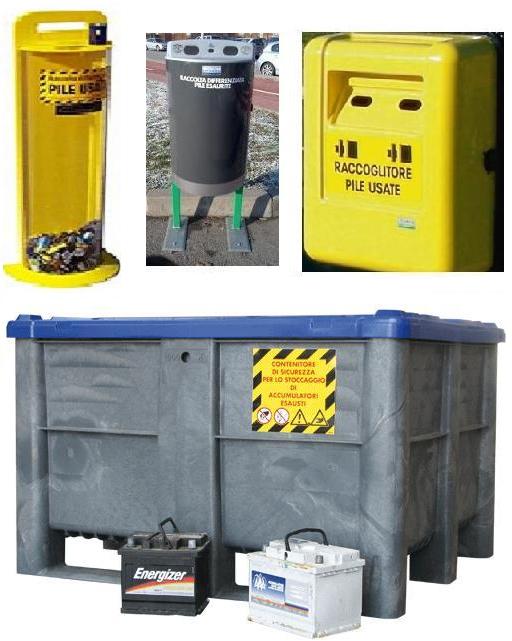Introduction
The continuous and constant technological progress provides a huge amount of portable electronic devices that need to be powered by batteries always smaller and more lightweight, rechargeable and long lasting.
Consequently the battery has become the fundamental element of the portable electronic equipment, and not only, the possibility to have large amounts of power and be able to provide in long times by means of a lightweight system and large capacity is of considerable importance in other fields such as cars and storage of large quantities of energy. In practice, the battery is a source of electrochemical energy which the dispensing occurs by chemical reactions taking place inside.
A bit of history
The birth of Battery required years of study and it is the result of the application of the fundamental laws of electrochemistry. The electric battery was invented in 1799 by Alessandro Volta professor of experimental physics at the University of Pavia in 1885, of which he became rector. Alessandro Volta was interested in experiments related to electricity on nerves, made by the professor of anatomy Luigi Galvani who observed that the muscle fibers of the legs of a dead frog twitched when placed in contact with two different metals. Thanks to this, he was able to show that the electric fluid was not generated directly by the muscles but by the contact between the two dissimilar metals separated by moisture.
In practice, Alessandro Volta, as he describes in his famous letter about his invention, written in French on March 20, 1800, and addressed to Joseph Banks President of the Royal Society of London, with its “artificial electric organ”, he reproduces the natural structure of the organ of the torpedo previously studied and described in detail by Galvani in his studies on electricity torpedoes.
Alessandro Volta in the letter, later published in the Philosophical Transactions of the prestigious scientific academy, describes his invention as a column composed of “copper discs, or rather silver, each applied to a piece of tin, or, which is much better, zinc, and an equal number of layers of water, or some other mood which is best conductor plain water, such as salt water, lye, etc.., or pieces of cardboard, leather etc.., well soaked in these moods“, calls this his apparatus artificial electric organ and submit it just like a natural reconstruction of the organ of the torpedo. Figure 1 shows a reproduction of the original “voltaic pile” which he defines as a unit column.
In the same letter to Joseph Banks, Volta also describes another version of his discovery: the crown of cups designed to overcome the problem of fluid leakage and its quick-drying that occurred with the system of stacking (see figure 2).
Because of this system of vertical stacking, the unit was called Volta’s battery. The principle of operation is based on the fact that each metal is characterized by a specific surface configuration of the electrons and thus is able to provide a different level of energy to its free electrons. This suggests that it is enough to combine and alternate between two different metals to obtain an electromotive force. In fact when the two materials are connected, through an electric wire connected to a possible load, a second contact between the metals of the stack and those of the electric wire connection is made.
In this way a potential opposite to that generated by the stack is generated resulting in the cancellation of the main electrical potential. The great intuition of Alessandro Volta was to separate the two different materials by placing them in contact with a material soaked in a saline solution, for this purpose defined two categories of material, the conductors of the first kind ie those constituted by metals and conductors of the second kind ie those consisting of electrolytic solutions.
Thanks to this insight, Alessandro Volta was able to decompose the contact potentials in two distinct types; one originated between metal and metal, and a rise in metal and saline. Since the potential that arises between the metal and the solution is capable of providing higher energy, it is able to prevail over that which is generated between the metal and the metal caused by the external connection. Figure 3 shows the block diagram of the operating principle of the great intuition of Alessandro Volta.
Over the years, combinations of metals and electrolytes were drawn more and more efficient. In 1859 the French physicist Gaston Planté realized a rechargeable battery that consisted of lead plates immersed in sulfuric acid, similar to that used in modern automotive industry, and in 1880 the first dry cell was constructed using a solid electrolytic substance. Since 1910 the technique has increasingly moved to the dry cell and with this type of element, more and more studied and perfected, it is mainly established modern battery industry.
Features
If you take for example a common stack like the one that is usually used for a TV remote, it is not correct to speak of battery, but rather of cell that is the smallest element of a battery. You should talk instead of battery when you are in the presence of more cells electrically interconnected to form a unitary whole which can be obtained with cells interconnected in series or in parallel, such as the battery of a remote control 3 V formed by two distinct cylindrical cells, each of voltage 1.5 V, put in series.
The conversion from chemical to electrical energy is made possible by the presence of two electrodes which are connected to each other within each single cell via an electrically conductive liquid (electrolyte). An electrode consists of a metal (zinc or lithium) that creates a negative potential (anode) in contact with the electrolyte. The second electrode is instead constituted by a oxygen-rich compound (nickel hydroxide, manganese dioxide, silver oxide) which in contact with the electrolyte generates a positive potential (cathode). The electrolyte can be liquid, for example an ionic solution, or solid as in the case of dry batteries generally defined “Leclanche”.
The batteries can be divided broadly into two main categories:
– Commercial or domestic batteries use are those that are found in most everyday applications. They are characterized by a low voltage and are used in various applications, remote controls, mobile phones, radios, toys, laptops, watches, portable lamps, and flash cameras, measuring instruments, etc.( see Figure 4);
– Industrial batteries are much larger than the commercial ones. They are used both to provide power to industrial machines and automobiles, and to storage large quantities of energy coming especially from plants for production of renewable energy or thermal generation (see figure 5).
The main characteristics of a battery that you need to know in order to achieve a correct dimensioning of power supply to a given load, are:
– Nominal voltage in volts, depends on the chemical technology used and not on the physical quantity. This parameter identifies the type of battery and corresponds to the average voltage that can be delivered by the battery;
– The maximum voltage, expressed in volts, shows the maximum voltage that the battery is capable of delivering in the condition of full charge. This parameter is important for the purpose of not exceeding the voltage indicated by the manufacturer of a particular equipment, in case of replacement;
– Capacity, expressed in Ah (much used is also its submultiple mAh) represents the amount of electricity that the battery can deliver in a time interval. For example a battery with a capacity of 2 Ah can provide continuously a current of 2 A for one hour or 1 A for two hours or even 0.5 A for four hours. In practical applications, however, these data are relative, because in reality the capacity refers to a level of constant discharge and to a certain threshold voltage; if these parameters change during operation, it also changes the capacity of the battery. The product of the capacity with the rated voltage is expressed in Wh;
– Energy density or specific energy is the amount of energy stored per unit mass or volume, and is a very important parameter in cases in which you want to obtain a high energy level, limiting the weight or volume. To give an example with the car, 1 kg of gasoline contains about 13 kWh of energy against 0.1 kWh of stored energy in 1 kg of one of the best current batteries. In practice the energy density, expressed in Wh / m 3, is the ratio between the stored energy and the unit volume, while the specific energy, expressed in Wh / kg is the ratio between the stored energy and the unit mass from which it is dispensed.
– Duration, represents the number of cycles of charge / discharge the battery is able to withstand, or how many times it is able to charge and discharge up to a value not less than 80% of its capacity. The life of a battery is a parameter that appears to be highly variable since it is largely influenced by the conditions of use. For this reason it is very important to observe the operating conditions, the method of charging and maintenance instructions provided by the manufacturer;
– Characteristic temperature is a parameter that indicates the temperature limits within which the battery is working properly. For example, at low temperatures, the electrolyte may freeze, while at high temperatures, a change in the redox reaction can occur;
– Self-discharge is the discharge rate of a battery when it is not connected to the load. It is a parameter related to the temperature and the type of the battery, increasing the temperature increases the effect of discharge;
– C index is a parameter that indicates the average current that the battery supplies if it is discharged in an hour. An index C indicates the current intensity in Ah in the case of discharge in 1 hour, an index C / 5 in the case of discharge in 5 hours, an index 2C represents the current intensity in the case of discharge in ½ hour. Knowing this parameter is especially important in those cases where it is necessary to power equipment with a high consumption.
From a technical point of view, the batteries can be divided into two broad categories:
a) primary batteries, once they are discharged, can no longer be used;
b) secondary batteries or accumulators, once they are discharged, can be recharged several times by using a specific power supply, battery charger.
Finally, from the point of view of the shape:
- cylindrical batteries
- button batteries
- batteries with a rectangular base
- battery power-pack
All types of primary and secondary batteries contain poisonous chemical compounds and heavy metals such as sulfuric acid, lead, cadmium, chromium and mercury in a particular way, which make them classifiable as highly polluting waste. For this reason, the law obliges them separate collection and, above all, the stores have a duty to inform buyers by means of a visibly well-placed notice listing the disposal options, products and/or packaging and/or usage instructions.
Primary batteries
The most common types of primary batteries are:
– Alkaline batteries are the most popular and economical. They are commercially available in all sizes and have a low self-discharge. They can also keep up to more than five years when not in use. They have a high internal resistance and therefore the voltage decreases significantly in case of request of high values of current. The performance of these batteries decreases at low temperatures;
– Lithium batteries have a high specific energy (up to 400 Wh / kg) which allows to have reduced weight and size for the same energy supplied. Precisely because of this characteristic, their most common form is that of a “button”. They are used especially for watches, wireless alarms, digital cameras, appliances acoustics. Their duration can also reach five years, and during preservation it has a very low self-discharge with losses of less than 1% per year;
– Zinc-carbon batteries are the most used due to the reduced cost. They have a self-discharge high enough, they are suitable for all uses such as portable lamps, toys, portable electronic devices;
– Mercury batteries utilize mercury dioxide and for environmental reasons, similar to thermometers, they have been banned and therefore no longer be used;
– Silver oxide batteries are generally in the form of a button and are suitable for the power of wrist watches, pocket calculators, medical equipment, cameras. The anode is made of zinc dust, the cathode with silver oxide and the electrolyte is a caustic organic potash.
Secondary Batteries
The most common types of secondary batteries are:
– Lead-acid batteries are filled with sulfuric acid and are also available with the acid in the form of gel to prevent leakage. This type of batteries must be constantly kept charged and it is not advisable to subject them to complete cycles of charge / discharge. They supply a constant voltage through a current limiting device. This type of batteries are used in the automotive field, in some types of electronic instruments, in UPSs and backup systems in general;
– Ni-Cd (Nickel Cadmium) batteries are the oldest technology and characterized by a remarkable memory effect (characteristic of remembering how much percentage of the discharge has been requested in previous uses,
in essentially they store as much energy as was used previously and are recharged only for that) so we need to fully discharge before submitting them to a new charging cycle. They have a high value of self-discharge and the presence of cadmium makes them highly polluting;
– Nichel-Metal Hydride (Ni-MH) batteries have now completely replaced the Ni-Cd and are available in popular formats. They have a double capacity than Ni-Cd and can be recharged in 2-4 hours. The memory effect is almost null and discharge cycles can be made occasionally. Their capacity is reduced at low temperatures, they also have a higher value of self-discharge and must be recharged with a battery charger with charge control since they are sensitive to overcharging;
– Lithium Ion (Li-Ion) batteries are the latest generation and provide more power with less size and weight. Their shapes and sizes are specific to the powered device. it is better to recharge them often and before being fully discharged. Their useful life is measured by the total energy that enters and exits the battery, instead of keeping into account the number of cycles of charge and discharge. They are subject to a very low self-discharge rate of about 1% per month. For this reason they may remain unused even for several months. Fully discharge these batteries is a serious error, you should charge them when there is not less than 25% charge;
– Molten salt batteries exploit the chemical properties of sodium as the electrolyte and to activate them, a temperature of about 100 ° C is necessary to obtain the fusion of sodium. Due to the high operating temperature of these batteries, they present significant safety issues. These batteries are mainly used to store the energy of renewable sources such as solar and wind power;
– Redox Batteries (Reduction-Oxidation) are based on an electrochemical redox system through which the energy is stored in two solutions containing different redox couples. In practice consist of two tanks containing the anodic and cathodic solutions. They are characterized by a high capacity which makes them suitable for storage of large quantities of energy. Moreover, their response time is very fast, and for this reason they are particularly suitable for UPS. This type of battery is also referred to as “battery of flow” since it generates energy through the circulation of a liquid (a mixture of hydrochloric acid and sulfuric acid) from an external tank towards the center of the battery. Currently, a major disadvantage of this technology is that the operating temperature must be between -5 and 50 ° C but the continuous advances in manufacturing techniques and technology allow a considerable development of this new technology for the future;
– Supercapacitors are energy storage devices far superior compared to conventional capacitors, arriving in capacity over the five thousand farad. The technology is based on the phenomenon of the electric double layer, a dielectric separates the two electrodes. When it is charged it generates an electric field in which energy is stored. The supercapacitors may be loaded and unloaded almost instantaneously and have a number of cycles of charge / discharge much higher than in all other accumulators. As only disadvantage they have a very low level of specific energy. Figure 6 shows some types of supercapacitors.
Designation codes
As in the case of sockets and plugs, also in the battery there is still no legislation for a global standardization. For this reason, in the market there are standard batteries recognized and marketed in many states and the batteries proprietary, ie those which assume forms, features and abbreviations particular, exclusively realized by the various producers for marketing or for its own electronic equipment, such as in case of mobile phones and automotive industry where every manufacturer uses a different form of battery.
The most important international organizations related to technical regulations and size of the batteries, whose regulations were harmonized, are the IEC (International Electrotechnical Commission) and ANSI (American National Standards Institute),. For example, for primary batteries there are the IEC standards 60086 while for the ANSI there are regulations C18.
Labeling IEC is based on a code of letters and numbers where the letters indicate respectively the chemical element and the shape of the battery, while the numbers which precede the letters represent the number of cells and those which follow the letters stand for the size the battery. Other letters can then follow the labeling. These are major changes and features. ANSI labeling is always based on a code of letters harmonized with the IEC but the numbers that follow represent a code associated with a certain size, for example, the code:
- 13 is equivalent to the size of the labeling R20 IEC;
- 14 is equivalent to the size of the labeling R14 IEC;
- 15 is equivalent to the size of the labeling IEC R6;
- 24 is equivalent to the size of the labeling R03 IEC.
Since there is still no single international standard that establishes a compulsory standardization, most battery manufacturers uses its signature and then provide detailed information about the IEC compatibility. Here are some examples based on the harmonization IEC / ANSI, ( see Figures 7 and 8):
LR03, other identifying name AAA, refers to a cell with zinc and manganese dioxide electrode and an alkaline electrolyte with a rated voltage 1.5 V (the letter L); cylindrical, nominal diameter 10.5 mm, height 44.5 mm, (code R03); equivalent ANSI designation 24A; this battery such like Varta is marketed as LONGLIFE EXTRA 4103;
LR6, other identifying name AA , refers to a cell with zinc and manganese dioxide electrode and an alkaline electrolyte with a rated voltage 1.5 V (the letter L); cylindrical, nominal diameter 14.5 mm, height 50.5 mm (code R6); equivalent ANSI designation 15A; this battery, for example, is marketed as Duracell MN1500;
LR1, other identifying name N, refers to a cell with zinc and manganese dioxide electrode and an alkaline electrolyte with a rated voltage 1.5 V (the letter L); cylindrical, nominal diameter 12 mm, height 30.2 mm, (R1); this battery, for example, is marketed as Duracell MN9100;
LR14, other identifying name C, refers to a cell with zinc and manganese dioxide electrode and an alkaline electrolyte with a rated voltage 1.5 V (the letter L); cylindrical, nominal diameter 26.5 mm, height 50 mm, (R1); equivalent ANSI designation 14A; this battery, for example, is marketed by Duracell as LONGLIFE EXTRA 4114;
LR20, other identifying name D, refers to a cell with zinc and manganese dioxide electrode and an alkaline electrolyte with a rated voltage 1.5 V (the letter L); cylindrical, nominal diameter 34.5 mm, height 61.5 mm, (R1), equivalent ANSI designation 13A; this battery, for example, is marketed as Duracell MN1300;
6LR61, other identifying name D, is referred to a battery of six cells with electrodes Zinc and manganese dioxide and alkaline electrolyte with a nominal voltage 9 V (letter L); cylindrical, nominal diameter 34.5 mm, height 61.5 mm, (R1), other identifying name D; equivalent ANSI designation 1604A; this battery, for example, is marketed by Varta as LONGLIFE EXTRA 4122;
SR63, button cell, is referred to a cell with electrodes zinc and silver oxide and alkaline electrolyte with a nominal voltage 1.55 V (the letter S); of cylindrical shape, nominal diameter 5.8 mm, height 2.15 mm, (code R63); this battery, for example, is marketed as the Varta V379 and the as Duracell D379;
CR2025, button cell, refers to a cell with electrodes of lithium and manganese dioxide and organic electrolyte with a rated voltage 3 V (letter C); of cylindrical shape, nominal diameter 20 mm, height 2.5 mm, (code r2025); designation equivalent ANSI 5003LC; this battery, for example, is marketed by Duracell DL 2025.
Some Useful Tips
– Used batteries are highly polluting components and are therefore classified as special waste. These are not to be abandoned but should be collected in suitable containers or public places at the local ecological. Figure 9 shows some types of dedicated containers. The DL 188/2008 “Implementation of Directive 2006/66 / EC on batteries, accumulators and their waste and repealing Directive 91/157 / EEC” in force since 18/12/2008, extends the recovery and recycling of batteries containing lead already implemented from 1988, to all types of batteries that use other metals or chemical compounds. In particular, it sets targets for the collection and disposal with regard to batteries and accumulators and also establishes that by 26 September 2016 will be achieved a minimum collection rate of 45% of the quantity placed on the market.
In this regard the decree provides for the establishment of a Centre of Batteries and Accumulators coordination (CdcPA) non-profit organization, to which all producers must participate with the task of implementing the operations of collection, treatment and recycling together with information campaigns on correct disposal of batteries and accumulators to end of life. This Centre provides that the end users will be able to dispose of such waste free of charge at the collection points closest in special centers or municipal containers, depositing them in special containers from distributors themselves without any obligation to buy new ones.
The DL 188/2008 defines the manufacturer as: “any person who places batteries or accumulators, including those incorporated into appliances or vehicles, on the national market for the first time on a professional basis, irrespective of the selling technique used, including remote communication techniques as defined in Articles 50 and following of Legislative Decree 6 September 2005, 206, transposition of Directive 97/7 / EC on the protection of consumers in respect of distance contracts. “
– Never use equipment intended for operation in rechargeable battery without them, feeding them directly from the network. In case of malfunction of the power supply charger, or rapid fluctuations of the network, without the rechargeable batteries included equipment could result in serious damage;
– Do not charge the battery too long. Always check that the charger is equipped with a charge controller, otherwise a good practice is to connect a timer to automatically turn off after evaluating charge time by analyzing the capacity of the battery and the amount of energy supplied from. For example, if you need to recharge a 5A battery and the power supply supplies a current of 2.5 A/h, you should do so that the charge does not exceed the 2 hours;
– The batteries, especially the secondary ones, are still the most critical element of the portable electronic equipment. Despite recent advances in new manufacturing technologies after a certain number of charge cycles, about 700-800, they gradually lose power after a certain period and their charge lasts less and less, until you will need to replace them;
– The temperature is an important feature for the proper functioning of the batteries. The chemicals inside them can be exhausting with extreme heat or freeze at low temperatures. For these reasons, it is good practice to use them at temperatures not lower than 0 ° C and not higher than 45 ° C. Especially do not subject them to extreme temperature changes, such as leaving them exposed to sunlight for a long time and immediately after exposing them to a very low temperature;
– Never use batteries which show obvious signs of abnormalities such as damage to the outer casing and in particular signs of swelling even light;
– In the case in which the portable equipment is not used for a long period (20-30 days), it is good practice to remove the battery or cell and store the rechargeable with a charge of about 50% in environments without excessive temperature changes. Leaving the battery fully discharge may result in the condition of non-maintenance of successive positions,
whereas leave it fully charged can lead to a deterioration of the capacity with a consequent reduction of autonomy;
– When using any battery is a good idea to carefully read the specifications provided by the manufacturer of the equipment. There is a direct correlation between the size, the number of cells and the ability of the battery. For example batteries composed by six cells may have a capacity of 6600 mAh or 7900 mAh or 8800 mAh according to the construction techniques;
– In case of power supply with more batteries, never mix old and new batteries or use different brands;
– Clean occasionally contact surfaces of the battery using a pencil eraser and gently rubbing;
– Never put a rechargeable battery in a charger that is not specifically for that type of battery, and especially not recharge a battery unless specifically labeled as rechargeable. The attempt could cause the battery to explode and cause serious damage;
– If you are not using the batteries, keep them in the original packaging provided by the manufacturer or provide adequately to isolate the poles assets in order to avoid any accidental contact with metal objects such as coins or keys that could cause a short circuit causing a dangerous overheating.[:]

